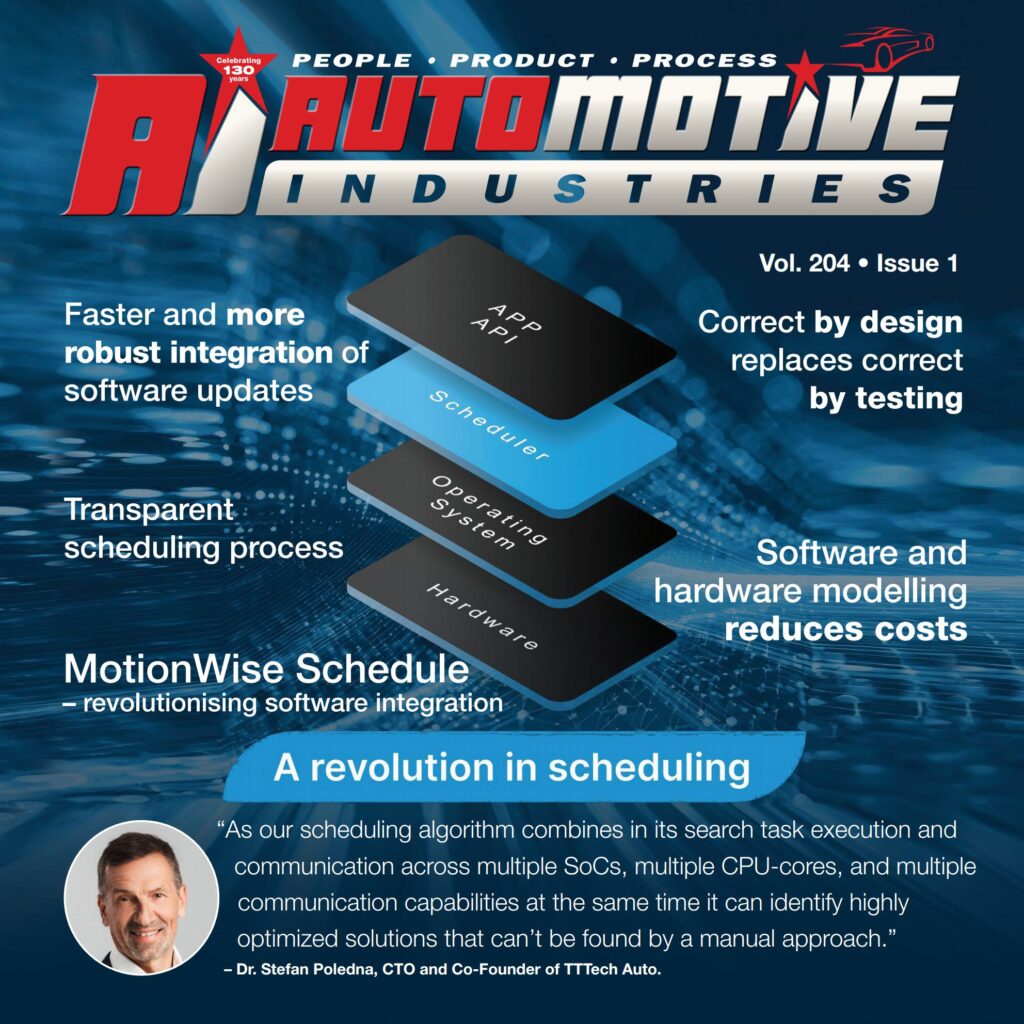
In today’s rapidly evolving automotive landscape, the concept of software-defined vehicles (SDVs) has emerged as a focal point for innovation and progress.
SDVs represent a transformative shift in the industry’s approach to vehicle technology as they allow for new business models which create ongoing revenue streams through value-added paid software updates during the lifecycle of the vehicle.
TTTech Auto, a leading provider of automotive safety solutions, has introduced MotionWise Schedule – a groundbreaking application designed to revolutionize automotive safety and reliability through SDV platforms.
The evolution of automotive architecture
SDVs need an electronics architecture that provides plenty of headroom in terms of computational power, communication bandwidth and memory to enable this constant stream of SW updates with improvements and innovations.
Traditional E/E architectures with their large number of small ECUs with little to no headroom offer no place and no free resources for those updates.
Hence, more centralized compute architectures with High-Performance Computers (HPCs) providing the necessary headroom for constant updates are becoming necessary.
They need to provide the resources to seamlessly integrate much more functionality, also including in many cases safety-critical and security-related functions.
With this steep increase of functionality in an HPC, complexity is skyrocketing during the integration process of these systems.
Today’s limits with the correct-by-testing approach
In the past a correct-by-testing approach was prevalent.
This included manual integration steps, manual tuning of priorities for software component execution, manual allocation to CPU cores and manual setting of communication priorities.
Extensive testing was necessary to ensure that all real-time and safety requirements were met under all corner cases.
For the next wave of complex SDVs and the dramatically increased number of SW components that are integrated in an HPC, this approach is no longer feasible: it is too time consuming and costly with all its iterations, and at a certain level of complexity it is no longer possible to test for all corner cases.
MotionWise Schedule: a game-changing solution
In addressing the complex challenges of SDV SW integration, TTTech Auto employs a radically new correct-by-design philosophy.
MotionWise Schedule automates the manual process steps and searches for solutions that satisfy all corner cases.
It uses a model of the software components and their communication relations with constraints such as execution periods, precedence constraints, and end-to-end latency constraints.
Furthermore, the hardware resources are modeled: CPU cores, hardware accelerators as well as communication capabilities such as shared memory or Ethernet TSN.
The MotionWise scheduler uses highly advanced and sophisticated methodologies and automatically searches for an allocation of the software components to the hardware resources that satisfy all the constraints under all corner cases with its correct-by-design approach.
By prioritizing correctness-by-design, TTTech Auto aims to set new standards for automotive safety and reliability, shaping the future of mobility.
Thus, “MotionWise Schedule” enables an accelerated and more robust SW integration process.
Its correct-by-design approach supports safe real-time execution and communication, vastly reduces testing efforts, and allows a higher resource utilization.
Already deployed on the streets at European and Asian car manufacturers, TTTech Auto’s middleware platform MotionWise showcases its effectiveness in serial production. Leveraging sensor fusion and advanced computing capabilities, MotionWise Schedule delivers critical safety information at the right moment, ensuring optimal performance and reliability in milliseconds – a feat that was previously unimaginable.
A legacy of innovation
The development of MotionWise Schedule is rooted in TTTech Auto’s rich history of pioneering research in building safe real-time systems.
With over 30 years of experience in this area, TTTech Auto has continuously pushed the boundaries of technology, adapting to emerging trends such as x-by-wire technologies and fail-operational systems for Level 3 and Level 4 automated driving.
This legacy of innovation has positioned TTTech Auto as a trailblazer in automotive safety, driving advancements that shape the future of mobility.
Outlook – looking ahead
As the automotive industry continues to evolve, TTTech Auto remains committed to pushing the boundaries and raises the bar for even faster and more robust integration of software functionalities.
MotionWise Schedule is a key element along that journey that will be continuously improved to address new and even more powerful future SoCs along the way towards more centralized compute architectures and fail-operational requirements.
TTTech Auto is modularizing its middleware MotionWise platform, and will release further additional modules in the near future.
Automotive Industries (AI) asked Dr. Stefan Poledna, Chief Technology Officer and Co-Founder of TTTech Auto, how MotionWise Schedule addresses the challenges associated with exhaustive testing in software-defined vehicles
Poledna: Up to now, the industry has followed a correct-by-testing approach for scheduling of computation tasks and communication.
That means scheduling or priority assignment is done manually.
Every change then triggers an exhaustive testing and re-validation phase.
With the introduction of SDVs, we see that this approach no longer scales.

With SDVs high-performance or central compute ECUs become much more powerful.
At the same time, much more software is integrated and much more communication interactions take place, which makes it exponentially more difficult to test all corner cases.
For a complex SDV it is no longer feasible in our opinion.
MotionWise Schedule automates this process.
It uses a model of the software components and their communication relations with constraints such as execution periods, precedence constraints, and end-to-end latency constraints.
Furthermore, the hardware resources are specified, CPU cores, hardware accelerators as well as communication capabilities such as shared memory or Ethernet TSN.
The MotionWise scheduler then uses highly advanced and sophisticated methodologies to automatically search for an allocation of the software components to the hardware resources that satisfy all the constraints under all corner cases.
With this correct-by-design approach, it is still best practice to do proper testing for functional validation, but it is no longer necessary to rely on testing for all corner cases.
AI: Please explain how the scheduling algorithms employed by “MotionWise Schedule” optimize resource utilization and performance.
Poledna: On the embedded side, we employ the so-called time-triggered architecture (TTA).
This architecture employs time-triggered scheduling to decide which application gets access to the CPU cores at which time.
The schedule is computed at design time by MotionWise Schedule using all the aforementioned models and constraints and ensures the temporal correctness of each application.
As our scheduling algorithm combines in its search task execution and communication across multiple SoCs, multiple CPU-cores, and multiple communication capabilities at the same time it can identify highly optimized solutions that can’t be found by a manual approach.
AI: What are the key features of MotionWise Schedule that enable time-triggered execution and communication for real-time performance?
Poledna: The foundation of the MotionWise Schedule is time aware architecture (TTA), in which the principal component is a time-triggered execution of applications and a time-triggered transmission of communication messages.
On the application side of things, we have an embedded scheduling core that is tightly integrated with commercial operating systems that enable us to deploy such time-triggered execution paradigm for applications meeting high-performance and real-time requirements.
When we talk about communication, we use the mechanisms of the standardized Time Sensitive Networking (TSN), which enable us to manage multi-SoC architectures as it would be single logical layer.
AI: How does the support for dataflow-driven scheduling in MotionWise Schedule enhance flexibility for developers?
Poledna: The automotive world is not only time-triggered. Therefore, we implemented more flexible behaviors while still enabling us to provide real-time guarantees at the system level.
Our activity sequencer is an execution policy that merges with the time-triggered execution of applications but allows developers to specify and execute a data-driven workflow, bringing them flexibility during development, while keeping the timing properties at the system level to ensure the integration feasibility.
This feature was developed having the SW development teams in mind, and we conducted several interviews with perception and sensor fusion layer teams, to come up with the right solution.
It is important to specify that there is strong isolation in the temporal domain between these two merged scheduling paradigms such that there is no disturbance in the execution of the critical applications if there are errors or overflows in some part of the system.
During this year, we will extend the feature scope, providing more flexible aspects to accommodate early development phases.
AI: Please elaborate on how MotionWise Schedule ensures end-to-end latency bounds for computation chains across multiple CPU cores and SoCs.
Poledna: When we merge all the technology embedded within the product, we can define so-called computation chains that represent temporal execution dependencies between applications running on different SoCs or CPUs.
Moreover, computation chains also include the consumed or produced communication data of these interdependent applications when they communicate e.g. via a Time Sensitive Network (TSN).
We exploit the standardized mechanisms from TSN to precisely schedule critical messages in network devices such that they align with the execution of the producing and consuming

applications.
The important aspect is that everything works with a click of a button (nowadays not even a button since it is integrated into a Continuous Integration and Delivery (CI/CD) cloud environment) and the scheduling process is transparent to the user.
AI: What mechanisms does MotionWise Schedule provide for task monitoring and real-time analysis to optimize system performance?
Poledna: We include several components to enable the monitoring of applications, an embedded task monitoring that monitors the execution of applications, enabling us to get information about their behaviors as well as to connect it to a health infrastructure to react in case we identify any misbehavior.
Furthermore, we use the same data to inflow it into our visualization tools, giving the data insights on the running system and enabling the comparison with the initial model (planed vs actual execution).
AI: How does MotionWise Schedule ensure time synchronization across multiple SoCs and Ethernet TSN for minimized latency and real-time execution?
Poledna: MotionWise Schedule includes a Time Synchronization component, enabling a common notion of time across all nodes in the distributed system.
This component enables the application scheduler and network to work on the same time basis (with a synchronization accuracy less than 100 microseconds).
AI: Please explain how the standard-friendly nature of MotionWise Schedule supports integration with various automotive architectures.
Poledna: Automotive OEMs make use of different approaches to create their software stacks, but usually rely on available standards, such as AUTOSAR, TSN, POSIX, and DDS.
MotionWise embeds these technologies.
Hence it can be deployed in SW Architectures that make use of the standards mentioned above.
AI: How does MotionWise Schedule streamline the SW integration process and reduce testing efforts, leading to faster production timelines?
Poledna: Our correct-by-design approach reduces the testing efforts and time despite the continuous exponential growth in complexity.
Furthermore, our tools streamline the configuration and generation process, making it easier to derive correct embedded configurations, not only for MotionWise Schedule but also for other components such as the operating systems and networking devices.




1 thought on “TTTech Auto pioneers next-generation automotive safety with MotionWise Schedule”